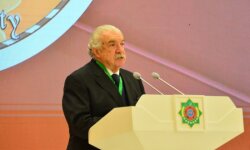
In 2023, the transport sector ranked among the dynamically developing sectors of Turkmenistan’s economy. It includes the automotive, rail, air, sea and river industries. An economic analyst Valentin Trapeznikov commented on the growth rates in Turkmenistan’s transport sector in an interview with CentralAsia.news.
Development dynamics of the transport sector
The high development dynamics of the above-mentioned industries is illustrated by the economic indicators they achieved over the 11 months of 2023. During this period, the growth rate of works performed and services provided in the sector as a whole stand at 121,3%, freight transportation by road, rail, air, sea and river transport — 103,9% and passenger transportation — 105,1%.
The growth rate of services provided in the industries is high as well. For railway transport it stands at 106,5%, road transport — 117%, air transport — 199%, sea and river transport — 105,2%.
Currently, Turkmenistan is earning a reputation of a major transport hub in the region. Transit goods are transported through its territory, which is vital to foster economic development in the country and strengthen friendly relations with other countries. In 2023, 20,4% more transit goods were transported through the territory of Turkmenistan compared to 2022.
Automotive industry
Road transport has a special place in Turkmenistan’s transport sector. It plays a leading role in short and medium distance transportation. During the analysed period, the share of road transport accounted for 49,4% of the total freight volume and 84,7% of the total passenger volume.
Compared to 2023, the transport organisations of the Turkmenavtotrans Agency increased their freight volumes by 2,9% and passenger volumes by 5,0%. The volume of services provided by these organisations increased by 16,5%.
Material and technical resources of the industry are being modernised through purchasing passenger buses, cars and trucks made in Japan, South Korea, Russia and China. Currently, the Turkmenavtotrans Agency has about 6,500 vehicles of various models at its disposal.
Rail industry
In Turkmenistan, rail transport takes a lead in transporting goods across long distances. It is also best suited for transporting large-sized and large-tonnage cargoes. Last year, the Turkmen Railways Agency increased its freight volumes by 6,0% and passenger volumes by 3.0 times compared to the previous year. During this period, transport service volumes were up by 5,8%.
In recent years, a number of major railway projects have been implemented. These included the Uzen-Bereket-Gorgan, Kerki-Ymamnazar-Akina, Ashgabat-Dashoguz, and Zerger-Kerki railway projects. The construction and connection of «steel» roads to the railway networks of neighbouring countries helps increase transit freight volumes.
Material and technical resources of the industry are being modernised through purchasing modern equipment from the well-known rolling stock manufacturers in Russia and China.
Air industry
Turkmenistan’s air industry is developing intensively as well. This is vividly illustrated by the high economic indicators in this industry. In 2023, the organisations of the Turkmen Airlines Agency increased passenger volumes by 128%, freight volumes by 56% and transport service volumes by 101,3%.
New airports stuffed with state-of-the-art equipment are being built, reconstructed and put into operation in all the regions of Turkmenistan. The national air fleet is regularly replenished with modern aircrafts and helicopters. New air routes for carrying freight and passengers are created, including to Europe, Asia and other destinations.
Marine and river industries
During the years of independence, Turkmenistan has implemented the large-scale projects aimed at developing and modernising maritime and river transport infrastructure, and has increased freight and passenger volumes.
The economic indicators of water transport are steadily improving. The Turkmen Sea and River Transportation Agency increased freight and passenger volumes by 19,1% and 56,4%, respectively, compared to the previous year, and transport service volumes were up by 4,2%.
Turkmenistan pays great attention to building up capacities of the national shipping fleet. In recent years, modern tankers and passenger and commercial vessels, the operational characteristics of which meet international standards, have been built and put into operation by order of Turkmenistan. Currently, a dredging vessel and 2 dry cargo ships are being built at the Balkan shipyard in Turkmenbashi.
In early 2023, the Turkmenbashi International Seaport intensified its role as a transit hub. Turkmen logistics companies carry freight from neighbouring countries that do not have access to the Caspian Sea and take an active part in the CASCA+ Multimodal Transport Project.
In the first half of last year, container freight volumes between the ports of Turkmenbashi and Alyat (Azerbaijan) increased 2.9 times. It is planned to resume regular container freight movements between Turkmenbashi and Makhachkala and set up a logistics centre of Turkmenistan in the port special economic zone in Astrakhan Region. This will help boost trade between Russia and Turkmenistan along the North-South transnational transport corridor.
Turkmenistan actively pursues the policy of transport diplomacy. In 2023, President Serdar Berdimuhamedov put forward a number of initiatives on international platforms to boost transport cooperation with the Central Asian and Caspian states, CIS Member States and Persian Gulf states, Hungary, Turkey and China.



